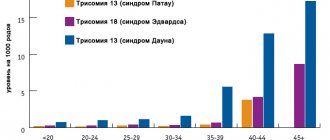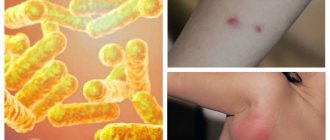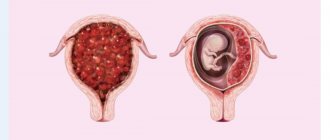Hemolytic disease (HDN) - symptoms and treatment
The development of hemolytic disease is possible only through contact between the blood of the mother and the fetus. During pregnancy, thanks to the placenta, fetal red blood cells enter the mother's body in small quantities, insufficient for the production of antibodies. At the time of delivery, due to abortion, miscarriage or complicated pregnancies, red blood cells enter the mother's bloodstream in large quantities, which causes the production of class M antibodies (IgM). These antibodies are formed almost immediately after contact with Rh-positive fetal blood. They provide temporary immunity from any foreign substances, but IgM are not able to penetrate the placenta to the baby.
Antibodies of class M are then transformed into antibodies of class G (IgG). They are produced 3 months after contact with Rh-positive red blood cells, provide long-term immunity for several years and are able to pass through the placenta into the fetal blood. This explains the fact that during the first pregnancy, these immune particles are not dangerous for the fetus, because during a normal pregnancy, the child’s blood mixes with the mother’s blood only in the last months of pregnancy or after childbirth, when IgG has not yet been developed.
During the first pregnancy, only recognition of the fetal red blood cells occurs, i.e., a primary immune response, which is also called “irritation” of the mother’s immune system. The term “sensitization” is also used for this process, and when applied to Rh conflict - “Rh sensitization”. The primary immune response is not dangerous to the fetus.
As a rule, a conflict regarding the Rh factor develops during a second pregnancy. This is due to the fact that by the time of the next conception, class G antibodies are already present in the mother’s body, so they begin to attack the red blood cells of the fetus already in the early stages. In this regard, the likelihood of developing this disease, as well as its severity, increases with each subsequent pregnancy. The disease occurs in 63% of children from women with sensitization.
It is important to understand that in the case of an abortion during the first pregnancy, regardless of the method used, the likelihood of sensitization (antibody production) in women with a negative Rh factor increases significantly. At the same time, the risk of infertility increases.
Maternal antibodies destroy fetal red blood cells in the liver and spleen, which disrupts the functioning of these organs. With a large amount of antibodies, damage to red blood cells occurs inside the vessels. In response to the death of red blood cells, the liver, spleen and bone marrow begin to produce reticulocytes (red blood cell precursor cells), which leads to their increase. This explains the development of symptoms of anemia and hepatosplenomegaly (enlarged liver and spleen) [7].
The breakdown product of red blood cells is indirect bilirubin, a bile pigment. Bilirubin is a toxic enzyme that damages the tissues of the brain, liver, lungs, kidneys, etc. A critical increase in the level of indirect bilirubin leads to irreversible damage to brain structures - bilirubin encephalopathy (kernicterus).
Factors in the development of kernicterus are prematurity, infections, hypoxia (lack of oxygen in the fetus), metabolic disorders (low or increased blood glucose levels), hemorrhages, taking certain medications (sulfonamides, salicylates, furosemide, diazepam, etc.) and alcohol consumption [2].
What is the reason?
If the mother has Rh negative blood and the child has Rh positive blood, then Rh incompatibility occurs. Because of this, the mother’s immune system can identify the fetus’s red blood cells as potentially dangerous, foreign, and begin to produce antibodies against the Rh factor located on them. Having attached to the child’s red blood cells, antibodies destroy them. Moreover, this process begins during the period of intrauterine development of the fetus and continues after the birth of the child. If the fetus has Rh-negative blood, and the mother has Rh-positive blood, then this situation does not arise.
Almost every second newborn baby has physiological jaundice - this is not a dangerous phenomenon. However, the skin of babies can turn yellow for another reason - due to the so-called hemolytic disease of newborns, the consequences of which are often much more serious. If your baby has been diagnosed with this, do not despair! With timely medical care, all processes in his small body will quickly return to normal and the risk of damage to the nervous system will be eliminated. To understand what the consequences of hemolytic disease will be, you first need to understand what this disease is and why it urgently needs to be treated. Let’s look at the example of hemolytic disease of newborns with group incompatibility, because it occurs more often and is somewhat easier than with Rh conflict. In this case, the mother has the first blood group 0 (I), and the fetus has another, usually the second A (II) or the third B (III). The basis of this disease is the massive breakdown of the fetus’s red blood cells due to the incompatibility of its blood and the mother’s blood. “Hemolysis” translated from Latin means destruction. The expectant mother, having the first blood group, has no antigens. Let’s denote the mother’s body in the picture with a “minus” sign. And the future child, i.e. the fetus has a second blood group, i.e. there is an antigen in his blood. In the picture, we will denote the fetus with a “plus” sign. If the fetus has an antigen, the mother’s immune system will begin to consider this antigen as a foreign enemy agent and will begin to produce protective antibodies (JgG) against this antigen. These antibodies can begin to be produced early - even during pregnancy, or they can appear almost during childbirth. The shorter the pregnancy period at which antibodies began to be produced, the more they accumulate and the more likely the baby will become more severely ill. These antibodies rush into the bloodstream to the fetus through the placenta, settle on the baby’s red blood cells and begin to destroy them. A lot of them are destroyed, and a large amount of bilirubin pigment is released from the destroyed red blood cells. This bilirubin is the "bad" bilirubin, it is called indirect bilirubin and is very toxic. It must be neutralized in the liver. But since at birth the child’s liver enzyme system is immature (it matures postnatally), it will not be able to completely utilize all bilirubin, there will be a lot of it, and its peculiarity is to accumulate in those body tissues that contain fat, then the ideal place for accumulation of bilirubin will be subcutaneous fatty tissue and clinically we will see jaundice of the skin. In addition, you should know that red blood cells also perform the function of delivering oxygen to all organs. And once they are destroyed, the oxygen supply function is disrupted, and first of all, one of the most vulnerable and not yet very developed organs of newborns will suffer - the brain, because it primarily needs oxygen supply. Why is indirect bilirubin toxic? Because it damages the cells of the heart, liver and, to a greater extent, brain cells, bilirubin intoxication occurs, characterized by lethargy, regurgitation, vomiting, pathological yawning, and decreased muscle tone. And at high critical values above 340 μmol/L in full-term infants and at 160 μmol/L in premature infants, “kernicterus” occurs - this is bilirubin intoxication of the brain, when the nuclei of brain cells are stained with bilirubin: muscle hypertonicity, stiff neck, and sharp “brain” appear. scream, the child reacts to all stimuli, a large fontanel bulges, muscles twitch, convulsions, strabismus, and breathing problems appear. The brightness of the icteric shade depends on the amount of this pigment in the newborn’s body. Jaundice can occur early (perhaps even in the first day of a child’s life) and persists for a long time. The liver and spleen are characterized by enlargement. The child's skin color is bright yellow, the sclera - the whites of the eyes - may be stained. If there is anemia, and there certainly is, because... red blood cells die, the baby will be pale and the jaundice may not seem so bright. Treatment for mild and moderate forms of this conflict is often carried out conservatively. Children undergo phototherapy, i.e. treatment with light, because When exposed to light, indirect bilirubin is destroyed. Adsorbents are also prescribed to help the intestines fight toxins. In severe conditions, a replacement blood transfusion is performed. If treatment is started late, the consequences of hemolytic disease can be dangerous - from the death of the baby to severe neurological disorders with signs of cerebral palsy, delayed psychophysical development, deafness, and speech impairment. Mild and moderate forms of pathology rarely (up to 10%) can leave a slight delay in motor development with a satisfactory state of mental abilities; conduct disorder; impaired movement functions, strabismus, hearing and speech impairment. Children with previous HDN do not tolerate vaccinations well, are prone to developing severe allergies and can often suffer from infectious diseases for a long time; teeth are often susceptible to enamel destruction and caries. During the treatment period, the baby is removed from breastfeeding, because Through breast milk, antibodies (JgG) will flow to the baby and jaundice will increase. After 15-20 days, after the antibodies disappear from the milk, the woman can breastfeed. Diet is very important for the mother of a newborn. Proper nutrition for a woman will ensure the supply of vitamins and eliminate exposure to harmful chemical additives. The mandatory diet must contain vegetables and fruits, fish, and liver. The main thing is that the products are fresh and natural. Children who have suffered from tension-type headache should be observed by a neurologist in a clinic and receive rehabilitation treatment. And in conclusion, I want to say that even having understood very little of what I described above, any reasonable person, including one who is far from medicine by occupation, is able to understand the consequences of hemolytic disease. The article was prepared by Natalya Fedorovna Kononova, head of the department of organizing medical care for children in educational organizations of the State Budgetary Institution of Healthcare of the Yamal-Nenets Autonomous Okrug “Gubkinsky City Hospital”.
How not to miss the symptoms of hemolytic disease
While the mother is pregnant, signs of blood incompatibility do not manifest themselves in any way in either the mother or the fetus. And after birth, HDN clinically manifests itself in different ways, depending on what form it takes: anemic, icteric and edematous. There are also cases of a combination of these forms. Let's look at them separately.
1. Anemic form. It is considered the easiest. Its manifestations are pallor of the skin, neurological disorders, for example, too much sleep, lethargy, apathy, poor appetite, and a sluggish sucking reflex. In addition, there are signs of enlargement of the spleen and liver, observed over time.
2. Jaundice form. The most common form. It is diagnosed in almost 90% of cases. With this form, jaundice is the most important symptom. Literally in the first hours of life, the skin and mucous membranes acquire a yellow tint, and enlargement of the liver and spleen is possible. The severity of the jaundice form is determined by the distribution throughout the body and the intensity of jaundice. This is determined visually using the Cramer scale. There are five degrees in total, with the first affecting the face and neck, and with the fifth the whole body. The intensity of jaundice depends on the level of bilirubin, which gives the skin its yellow color. A critical level of this enzyme can affect the neurons of the brain, its structures, and cause a serious and dangerous complication, bilirubin encephalopathy.
3. Edema form (“hydrops fetalis”). This is the most severe form, most often diagnosed in utero. The icteric coloration of the membranes, amniotic fluid, and umbilical cord did not go unnoticed by doctors. From the moment of birth, the child has swelling throughout the body - subcutaneous, abdominal, chest. The condition of the newborn is serious. Children diagnosed with this particular form of the disease require intensive treatment, including blood transfusions.
Immediately after birth, it is important for children, especially those at risk, to determine their blood type . Children who do not have the same blood type or Rh group as their mother should be examined by a doctor several times during the first day of life.
Mom herself may notice jaundice, as well as excessive pallor of the mucous membranes and skin. In this case, you must immediately inform your doctor.
HDN should not be confused with other diseases of newborns:
- hereditary hemolytic or posthemorrhagic anemia;
- non-immune hydrops fetalis;
- various infections, etc.
Only a doctor can make an accurate diagnosis; do not try to make a diagnosis yourself or downplay its importance.
Prevention of tension-type headache
Hemolytic disease of the newborn (HDN) is a pathological condition of the newborn, accompanied by massive breakdown of red blood cells, and is one of the main causes of the development of jaundice in newborns. Hemolytic disease of newborns (morbus haemoliticus neonatorum) is hemolytic anemia of newborns, caused by incompatibility of the blood of mother and fetus according to the Rh factor, blood group and other blood factors. The disease is observed in children from the moment of birth or is detected in the first hours and days of life.
Hemolytic disease of newborns, or fetal erythroblastosis, is one of the serious diseases of children in the newborn period. Occurring during the antenatal period, this disease can be one of the causes of spontaneous abortions and stillbirths. According to WHO (1970), hemolytic disease of the newborn is diagnosed in 0.5% of newborns, the mortality rate from it is 0.3 per 1000 children born alive.
Clinical symptoms depend on the form of the disease.
The edematous form (or hydrops fetalis) is rare. It is considered the most severe form among others. As a rule, it begins to develop in utero. Miscarriages often occur in early pregnancy. The skin of such a newborn is pale, waxy in color. The face is round in shape. Muscle tone is sharply reduced, reflexes are suppressed. The liver and spleen are significantly enlarged (hepatosplenomegaly). The belly is large and barrel-shaped.
The anemic form is the most favorable form according to the course. Clinical symptoms appear in the first days of a child’s life. Anemia, pallor of the skin and mucous membranes, and an increase in the size of the liver and spleen gradually progress. The general condition suffers slightly.
The icteric form is the most common form. Its main symptoms are:
- jaundice (yellow coloration of body tissues due to excessive accumulation of bilirubin (bile pigment) and its metabolic products in the blood);
- anemia (decrease in hemoglobin (the coloring substance in the blood that carries oxygen) and red blood cells per unit volume of blood);
- hepatosplenomegaly (enlargement of the liver and spleen in size).
Forms.
Depending on the type of immunological conflict, the following forms are distinguished:
- hemolytic disease of newborns (HDN) due to a conflict on the Rh factor;
- hemolytic disease of newborns (HDN) due to blood group conflict (ABO incompatibility);
- rare factors (conflict with other antigenic systems).
Clinical forms:
- edematous;
- icteric;
- anemic.
The following forms of the disease are distinguished according to severity.
- Mild form: diagnosed in the presence of moderate clinical and laboratory data or only laboratory data.
- Moderate form: there is an increase in the level of bilirubin in the blood, but there are no bilirubin intoxication or complications yet. This form of the disease is characterized by jaundice that appears in the first 5-11 hours of the child’s life (depending on the Rh-conflict or ABO-conflict), the hemoglobin level in the first hour of life is less than 140 g/l, the level of bilirubin in the blood from the umbilical cord is more than 60 µmol /l, increased size of the liver and spleen.
- Severe form: this includes an edematous form of the disease, the presence of symptoms of damage to the nuclei of the brain by bilirubin, respiratory disorders and cardiac function.
Prevention of hemolytic disease in newborns.
The basic principles of prevention of hemolytic disease of newborns are as follows.
Firstly, given the great importance of previous sensitization in the pathogenesis of hemolytic disease of the newborn, each girl should be treated as a future mother, and therefore girls should undergo blood transfusions only for health reasons.
Secondly, an important place in the prevention of hemolytic disease of newborns is given to working to explain to women the harm of abortion. To prevent the birth of a child with hemolytic disease of the newborn, all women with Rh-negative blood factor are recommended to administer anti-O-globulin in an amount of 250-300 mcg on the first day after an abortion (or after childbirth), which promotes the rapid elimination of the child’s red blood cells from the blood mother, preventing the synthesis of Rh antibodies by the mother.
Thirdly, pregnant women with a high titer of anti-Rhesus antibodies are hospitalized for 12-14 days in antenatal departments at 8, 16, 24, 32 weeks, where they are given nonspecific treatment: intravenous infusions of glucose with ascorbic acid, cocarboxylase, prescribed rutin, vitamin E, calcium gluconate, oxygen therapy; if a threat of miscarriage develops, progesterone and endonasal electrophoresis of vitamins B1 and C are prescribed. 7-10 days before birth, phenobarbital 100 mg three times a day is indicated.
Fourthly, when a pregnant woman’s anti-Rhesus antibody titres increase, delivery is carried out ahead of schedule at 37-39 weeks by cesarean section.






